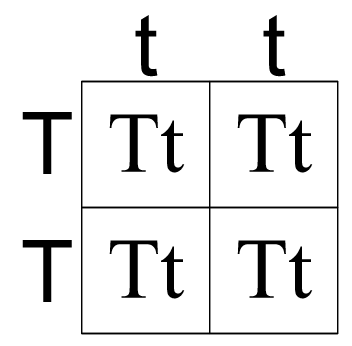Punnett Squares are often used by geneticists to determine the possible results and probability when different levels of dominant and recessive alleles are mixed. Punnett Squares are traditionally drawn with the dominant allele first. Also, tradition dictates that the female is usually on the top, while the male is on the left, although neither of those has an effect on the overall outcome of the square. Punnett Squares can be very helpful, and the picture labeled Figure 1 above is an example of one.
As dominant traits are symbolized with a capital letter, while recessive traits are symbolized with a lower one, it can be seen that a homozygous (the word for something with two identical alleles for a trait) dominant, and a homozygous recessive set of organisms are being crossed. As seen in the actual square above, the results will all be heterozygous (the word for something with two different alleles for a trait). This means that while the offspring will all look like they are homozygous dominant, they have a hidden recessive trait that will show up in the next generation.
As dominant traits are symbolized with a capital letter, while recessive traits are symbolized with a lower one, it can be seen that a homozygous (the word for something with two identical alleles for a trait) dominant, and a homozygous recessive set of organisms are being crossed. As seen in the actual square above, the results will all be heterozygous (the word for something with two different alleles for a trait). This means that while the offspring will all look like they are homozygous dominant, they have a hidden recessive trait that will show up in the next generation.

 RSS Feed
RSS Feed